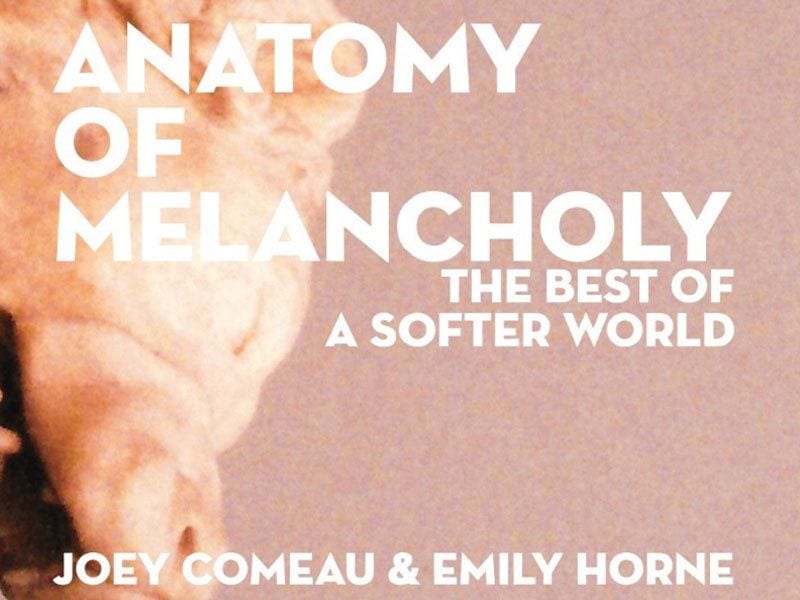
Beginning weekly in February 2003, the website ASofterworld.com began publishing a hybrid comics form that combined webcomics, poetry comics, and photocomics. The creators, Joey Comeau and Emily Horne, continued their collaborative project through June 2015, before making a selection available in book form. Anatomy of Melancholy: The Best of a Softer World features roughly 230 of the 1,248 comics archived on the website.
Most follow the standard newspaper comic strip format of three square panels arranged in an even row, though some are instead double rows of six—sort of like Sunday editions. All of the images are photographs, and all of the text is typeset in a black courier font and placed across the photos in thin white caption boxes shaped to the words—as if each phrase has been hand cut from a newspaper like a ransom note. The words combine haiku-like brevity with dark comic wit. Arranged as standard free verse, they might look like this:
I wonder how many
hauntings go
unreported
because wailing and
the clank of chains
are still better than
an empty house.
But Horne and Comeau arrange their phrases in fragments across the panels. Rather than a traditional left border, the panels serve as stanza units that move a reader’s eye left to right, usually with further shifts within each panel, producing even greater rhythmic effects.

Unlike the photocomics creators of Italian fumetti, Horne and Comeau use no speech bubbles or thought balloons. As a result, the speaker seems slightly aloof, an observer of the image rather than a direct participant of its depicted moment. And rather than placing captions at the top or bottom of panel edges, the creators always superimpose their phrase strips across their photographs, blocking some of the image content and so adding to the speaker’s indifferently sharp tone.
The photographs tend to feature individuals in varied locations, sometimes indoors, sometimes outside on streets or around trees or both. Other times they focus on pets or inanimate objects or architecture or landscapes. Whether color or black and white, the images have the feel of snapshots, as if culled from family photo albums rather than a collection of professional art prints. This helps to create the illusion that we are dipping briefly into the mundane particularities of strangers’ lives, sometimes exposing a specific character’s acerbic thoughts, other times pausing for an unidentified speaker to opine omnisciently before continuing to the next random intersection of passing interests.
Horne and Comeau’s most striking visual effects are through framing. They often reproduce the same photograph three times, cropping it differently in each panel. Rather than repetition, the new croppings either reveal new information that alters first impressions or emphasizes previous content in new and scene-altering ways. Sometimes the progression zooms slowly in, emphasizing certain aspects by eliminating others.

Other times the progression zooms slowly out, deemphasizing initial content by expanding its surroundings.

Still other times, the cropping progresses sideways, both revealing new and eliminating old content. In “I could never deny her anything,” the first image centers a young man pushing his apparent bride on a swing.

The second and third iterations move him incrementally out of frame until the bride is alone and centered and he is missing entirely. The progression, interesting in itself, resonates even more in combination with the text, since neither the text nor the images alone communicate the full effect of their combinations. The groom’s visual absence in the last panel is more meaningful because of his declaration that the relationship is over in the first, and the bride’s insatiable wish is selfishly destructive only because it removes him.
The croppings are inventive rather than formulaic, with many progressing orderly as described above, while many others fluctuate unexpectedly.
Horne and Comeau are also masters of gestalt effects. While most panel juxtapositions in comics require readers to fill in conceptual gaps—usually time leaps and changes in point of view—gestalt closure requires a more literal filling in of gaps by extending a single image across two panels as if the gutter between them erases an unseen middle portion. Horne and Comeau literally erase those gutter segments from their photographs, surprising a reader’s eye by offering no conceptual leap.

Usually they combine re-cropping and gestalt techniques within the same strips.
As with most comics, neither Horne and Comeau’s words nor images would work effectively in isolation. Most comics, however, don’t temp a reader to isolate their components, but poetry and photography often do stand alone. Here the combinations are happily everything. Though nothing like Peanuts and Garfield or even Calvin and Hobbes and The Far Side, they also conjure an imaginary universe in which A Softer World is just one daily strip on a newspaper page of dark and genre-disturbing funnies.

